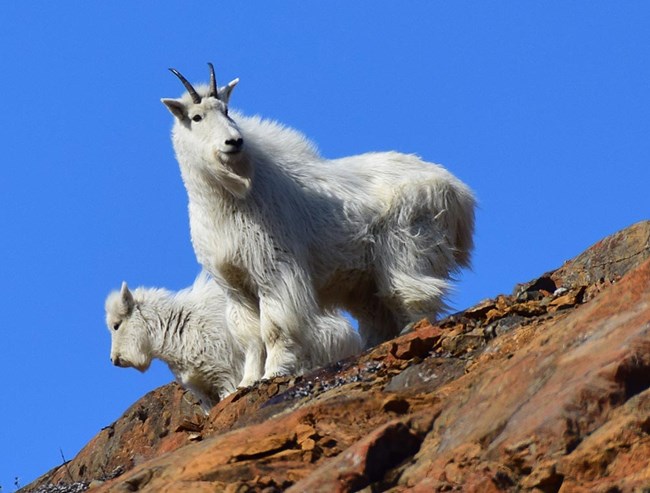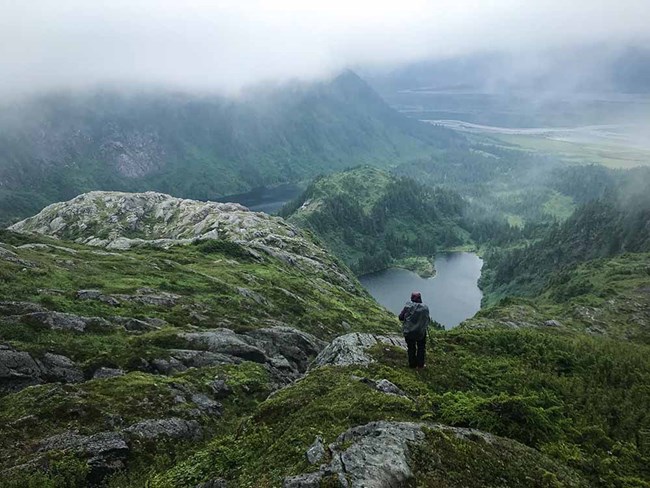Last updated: October 24, 2022
Article
Identifying Vulnerable Mountain Goat Populations

Mountain goats are the only alpine ungulate found in Glacier Bay National Park and Preserve and are a popular viewing species for visitors. Their highly specialized body shape, hooves, and fur allow them to live in steep, rocky habitats, high up in the alpine zones of mountains. Recent aerial surveys in the park indicated a decline in several mountain goat populations. Mountain goats are subject to increased mortality from disease, hunting pressure outside of park boundaries, lowered winter survival, and habitat degradation due to climate change. They are also susceptible to anthropogenic disturbance from airplanes, helicopters, and land-based recreation. Little information is known on the genetic population structure and connectivity of mountain goats within park boundaries. This study explored the genetic population structure and diversity of mountain goats in the park.

Genetic analysis indicated that Glacier Bay has three genetically distinct subpopulations of mountain goats. Marble Mountain and Table Mountain were both distinct from the other sampling areas, but surprisingly, Marble Mountain and Table Mountain grouped together as one subpopulation, indicating that there is movement of individuals between these two areas. Of the three subpopulations, Marble Mountain had the lowest genetic diversity, meaning that is it likely the most vulnerable to disturbance.
Climate change will likely have a strong negative effect on mountain goats in Glacier Bay. Our models indicated that population densities of mountain goats will decline in the net 65 years due to climate change, with some models showing populations even reaching quasi-extinction during this time. To avoid these drastic effects, mountain goats would have to either adapt to the changing climate which would be difficult given the rapid rate of climate change or move to more suitable habitat, often up in elevation or over to taller mountains. Unfortunately, climate change will not only directly affect mountain goat survival, but also the amount and location of suitable habitat. The change in amount and distribution of suitable habitat will result in less space and fewer movement corridors for mountain goat connectivity.
Quantifying the effects of recent glacial history and future climate change on a unique population of mountain goats
Abstract
Human disturbance and climate change can impact populations by disrupting movement corridors and reducing important habitat. Characterizing how animals respond to such environmental changes is valuable for conservation as many species, especially habitat specialists, can experience reduced genetic diversity when deleterious habitat change occurs, leading to an increased likelihood of extirpation. Mountain goats (Oreamnos americanus) exemplify this conservation challenge; their geographically isolated habitat can inhibit gene flow, making them susceptible to population declines in the face of anthropogenic-induced landscape change. To facilitate biologically informed population management of mountain goats in Glacier Bay National Park, Alaska, we characterized the fine-scale genetic population structure and examined how future climate change could impact the population density of these mountain goats. We used DNA samples to estimate diversity and depict the genealogical history. Climate response models allowed us to simulate changes to suitable habitat and predict how this might influence future population structure. Our results indicated that three genetically distinct subpopulations exist in Glacier Bay and that the population structure is reflective of the historic landscape patterns. Climate modeling predicted that demographic productivity was likely to be reduced for all subpopulations; additionally, we found that climate change likely degrades the suitability of movement corridors that facilitate gene flow between subpopulations, ultimately increasing the cost of travel. Understanding such fine-scale patterns are key to managing subpopulations, particularly with impending changes to the landscape.
Young, K. B., T. M. Lewis, K. S. White, and A. B. A. Shafer. 2022. Quantifying the effects of recent glacial history and future climate change on a unique population of mountain goats (biorxiv.org). Biological Conservation 272(109631): 1-8.
